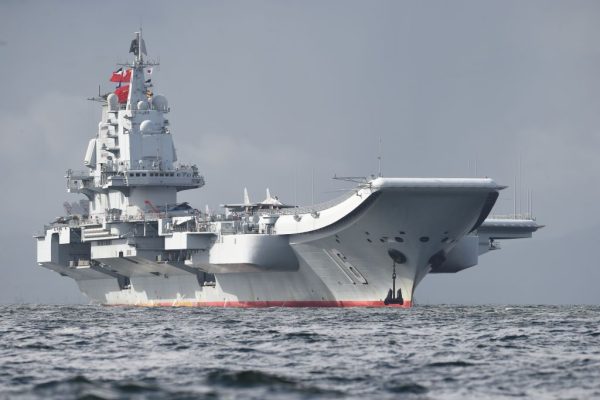In a significant step for its growing development, the Chinese People’s Liberation Army (PLA) Navy has launched its largest and most advanced aircraft carrier, the Fujian. Displacing more than 80,000 tons, the ship boasts electromagnetic catapults and arresting devices, a technology previously only seen in the American Gerald R. Ford class carriers.
Fujian, also known by its design number 003, was inaugurated in a “short but festive ceremony” on June 17 at the China State Shipbuilding Corporation (CSSC) shipyard located in Shanghai, as reported by Chinese state-run media. It was supposed to have been launched on June 3, the date of the traditional Dragon Boat Festival, but unexpected difficulties caused a two-week delay.
Fujian‘s launch is the newest major step in the communist regime’s naval ambitions, which are focused on domination of the South and East China seas, as well as the island of Taiwan.
The Type 003 is the first aircraft carrier to be both designed and built in China. The PLA Navy’s last carrier, the Type 002 Shandong, was constructed in the northeastern port of Dalian but based on the Admiral Kuznetsov, a Soviet design, while the Type 001 Liaoning, launched in 2012, was one of the two Kuznetsov-class ships before China bought it from Ukraine.

Refitting and building the Soviet designs gave China the experience it needed to set out on the ambitious Type 003 project.
A ‘quantum leap’
Success
You are now signed up for our newsletter
Success
Check your email to complete sign up
Ominously, the Fujian‘s namesake is the southeastern coastal province that lies directly across the strait from Taiwan and would be a staging ground for the mainland forces in the event of an amphibious invasion.
Communist China claims Taiwan as part of its core territory, and vows to “reunify” it with the mainland at any cost. Taiwan, governed as the Republic of China (ROC) that ran all of China before being driven to the island by communist rebels, has seen growing demand for formal independence — something Beijing has said would be a grounds for war.
What stands out most about the Fujian is its inclusion of an electromagnetic catapult, a technology currently only used by the U.S. military under the designation EMALS (electromagnetic launch system). Being based on Soviet technology, the Shandong and Liaoning relied on a ski-jump design, which limited the takeoff weight of carrier aircraft.
MORE ON CHINA’S MILITARY MODERNIZATION:
- China’s Construction of ‘Most Advanced’ Aircraft Carrier Nearing Completion: Satellite Images
- More US Ship-shaped Targets Appear in Chinese Desert: Satellite Images
- Xi Prepares Chinese Military for ‘Non-War’ Operations
Military analysts say the Fujian’s carrier design presents a “quantum leap” in capabilities when compared to its predecessors — greatly enhancing China’s combat power.
The EMALS launch system is able to accelerate jets with enormous force and will be able to carry more fuel and weapons. This is in contrast with the ski-jump design from which Chinese jets could not take off with a full combat payload.
Early warning aircraft will be able to take off and land more easily, enhancing the carrier’s ability to spot its enemies from further away. Further, the EMALS allows planes to launch with fewer delays between each takeoff.
China will be the only country in the world to employ this system outside of France and India, which have been developing similar systems but have yet to launch carriers equipped with the technology.
A closer look
At over 1,037 feet long, the Fujian will weigh around 100,000 tons when fully loaded, and is expected to carry about 40 combat aircraft, a significant boost from the Liaoning and Shandong, which each carry 24.
Earlier reports had indicated that the delays in Fujian’s launch may have been due to the strict “zero-COVID” protocols that the Chinese Communist Party (CCP) keeps on the books despite the massive economic and humanitarian costs. Satellite images showed the ship in its final stages of completion.
The Type 003 will not be combat-ready until at least 2024, as the PLA Navy will have to put it through sea trials and updates.
The U.S. Navy is currently the world’s leader in naval aviation, with 11 nuclear-powered carriers in service, and nine amphibious assault ships that can carry helicopters and vertical-takeoff fighter jets. The U.S. has built and operated several dozen carriers of many types since before World War II.
All American carriers are also nuclear-powered, with France the only other country currently fielding nuclear carriers.
Though the Fujian is conventionally powered, analysts have predicted that the next Chinese carrier will likely be a nuclear ship.
The Fujian‘s launch “is an important milestone for China’s military-industrial complex,” Ridzwan Rahmat, a Singapore-based analyst with the defense intelligence company Janes told NPR News.
“This shows that Chinese engineers are now able to indigenously manufacture the full suite of surface combatants associated with modern naval warfare, including corvettes, frigates, destroyers, amphibious assault ships, and now an aircraft carrier,” Rahmat said. “This ability to construct a very complex warship from the ground up will inevitably result in various spin-offs and benefits for the Chinese shipbuilding industry.”







